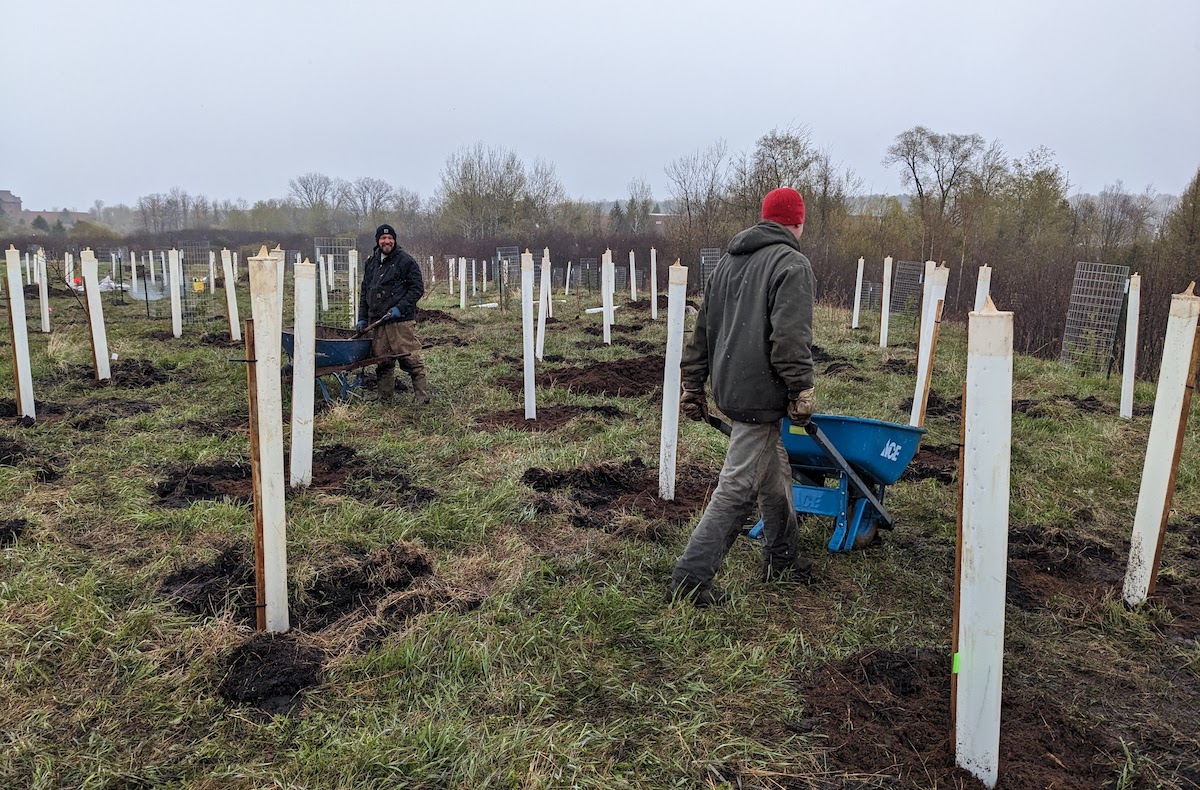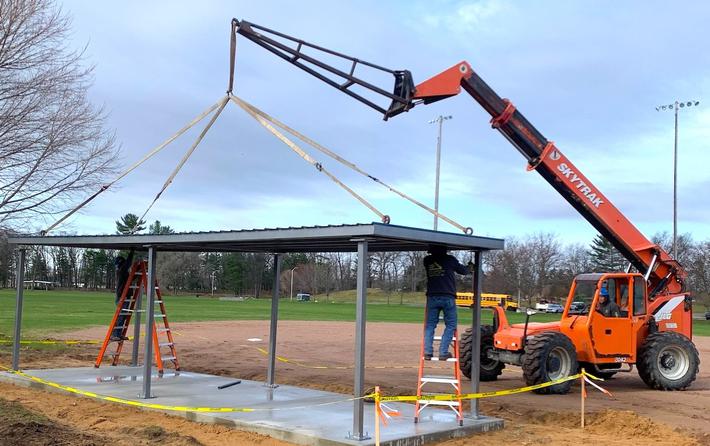
State of the Trees
Forest experts talk tree diversity, pests, migration, and more
By Al Parker | July 15, 2023
Whether you’re a hiker, mountain biker, or just an outdoorsy person who enjoys a shady stroll, northern Michigan forests offer a lush, living cathedral of peace in a sometimes hectic world.
But what’s the current health of that wooded sanctuary that we enjoy? Northern Express reached out to a pair of local forestry experts for answers.
Ellie Johnson is the District Forester for Grand Traverse, Leelanau, and Benzie counties. A native of Erie, Pennsylvania, she graduated from Clarion University in 2016 with a degree in Environmental Biology, then worked in several states before earning a Masters Degree in Forestry Resources. She moved to northern Michigan in 2021.
Daniel Schillinger is a registered forester, certified arborist, and owner of Schillinger Forestry and Northern Michigan Tree Doctor. After working as a forester for the Grand Traverse and Leelanau Conservation Districts for several years, he left the public sector to establish Schillinger Forestry in 2007. He serves private landowners and public entities across several counties in northern Michigan, including Grand Traverse, Leelanau, Benzie, Antrim, and Wexford.
Northern Express: When it comes to the overall health of our forests, where are we now?
Johnson: In northwest Michigan, we’re at the intersection of loss and opportunity. Many of our oldest trees in the second growth forests including paper birch, sugar maples, and oaks are in senescence, or on the downward slope of maturity. This is due to numerous natural factors that are exacerbated by human actions. Trees do succumb to old age, but alterations to local hydrology, drought conditions, and changing weather patterns can be physically taxing on a tree. Shifting seasonality—climate change—impacts a tree’s ability to create and maintain a leafy canopy, which in turn impacts photosynthetic rates and therefore long-term health.
However, losing trees frees up resources and space for forest regeneration. Inflated deer populations can be detrimental to young trees, but dedicated landowners can interplant and protect young trees in their forest to increase diversity and ensure future canopy coverage.
Schillinger: From a timber products perspective, growth of raw timber in the forest far exceeds harvest levels. Last I checked, growth was well over double harvest by volume. The greatest loss of forest cover is by far land use change, or development.
In terms of species diversity I think our diversity is declining, mainly due to exotic forest pests—emerald ash borer, beech bark disease, oak wilt, hemlock wooly adelgids, etc. Also, in my opinion, our northern hardwood, beech, [and] maple forests are having trouble regenerating naturally, and the main reason for this is white tail deer browse. With few predators, a declining number of deer hunters, and people making the huge mistake of feeding deer, we are seeing unprecedented levels of forest regeneration damage.
We as foresters and arborists work daily to mitigate the effects of these problems. These [are] issues we battle on a forest-by-forest case in the woodlands and a tree-by-tree level in the urban-suburban landscape.
NE: How has the tree cover in your area changed over the last decade or so?
Johnson: I’m not seeing much tree cover change in my area. There has been an increase in farms going out of production and beginning the process of reverting back to farmland, and there has simultaneously been an increase in property parcelization and development.
Schillinger: There are losses from development, yet forests are expanding edges and reclaiming unused “vacant” land. When we lose a tree or species of tree in the forest, there are other species willing to fill the gaps in short order, especially if they can grow past the deer browse. Forests are certainly resilient and showing this in spades, but we are definitely seeing unprecedented levels of exotic pest and disease damage as well. If a significant pest comes along which only attacks maple trees, this will be a significant problem for our forests.
NE: What species or areas are at risk, either from disease, insects, or human development?
Johnson: Hemlocks, particularly along the Lake Michigan shoreline, are at risk of hemlock wooly adelgid infestation. This is an invasive insect that, if left untreated, will kill a hemlock in four to 10 years.
Oak wilt is a non-native fungal disease that impacts the vascular layers of oak trees, fatal to the red oak group, and can kill a mature tree in a matter of weeks. There is no treatment for this disease, only preventative measures.
Beech bark disease is an insect-fungal complex where invasive beech scale feeds along the trunk and branches of beech trees and opens up the vascular layers to further infection from Nectria fungus species. Beech trees with heavy scale infestations are likely to suffer from canopy snap in wind storms.
Asian longhorned beetle is an invasive insect not yet detected in Michigan, but it’s one we should be on the lookout for because its favorite host tree is maples.
Schillinger: Most ash trees are dead from emerald ash borer, with the exception of those folks who invested in saving their ash trees with insecticide injections. Beech bark disease is slowly killing our beech trees. Research says only 1 percent of beech trees will remain after beech bark disease moves through.
Oak wilt is lethal to red oak trees, yet it’s easy to avoid getting if landowners follow the rules to keep it out of their property. This problem has the most support locally and the most average landowners doing “neighborhood watch” type activities making sure their neighbors do not injure or prune their red oak trees from April 15 through July 15 of any year. This public awareness and action has been neat to see over the last few years.
NE: What steps are being taken to protect our forests?
Johnson: There is a lot being done to both preserve and conserve our forests. A lot of land in my service area, both wooded and otherwise, is protected in perpetuity by the federal government, such as Sleeping Bear Dunes National Lakeshore with 71,199 acres, and land conservancies such as the Grand Traverse Regional Land Conservancy with 46,000-plus acres and Leelanau Conservancy with 14,000 acres.
However, the majority of land in my area is in private ownership, and thankfully, my community is active in managing their forests. My role is to be a free resource to offer technical assistance to private landowners, and I’m happy to report I’m a very busy person. Folks ask me great questions covering a variety of topics—forest health, climate resiliency, wildlife habitat, timber production, reforestation.
Schillinger: I could write you a 100-page treatise on this question alone. Way more is being done than the average person knows about or sees on a daily basis. My advice would simply be for your readers to seek qualified professional advice when making management and planting decisions. There are free resources like the local conservation districts and MSU Extensions where owners can start their quest for knowledge.
NE: How can the average person help?
Johnson: Educate yourself on what good management for your property would look like and take action! Your local conservation district and MSU Extension can help with this. Join your local conservation district, land conservancy, or other group on events like tree plantings and invasive plant control. Donate to groups like Crosshatch and Conservation Resource Alliance. Become involved with creating public policy that reflects environmental stewardship with groups like Citizens Climate Lobby.
Schillinger: Plant only native trees, shrubs, plants. Don’t feed wildlife. Don’t hire the cheapest option when planting or trimming trees. Seek professional advice when dealing with significant trees or forest problems. Buy American-made products. This comment is not meant to be political—all of the forest pests killing trees came from other countries, especially Asian countries. Buying cheaper, imported products has increased the amount of imported forest invaders hiding in wooden shipping crates.
NE: What will the next 10 years look like for our forests?
Johnson: It’s hard for me to predict what the next decade will look like because there are so many unknown factors. Climate change projections show a continued trend of milder winters and sporadic, heavier precipitation events. Air quality will continue to be impacted as fire season in western and northern forests becomes longer and more severe. We will lose many old trees due to increased drought conditions and other climate factors, and some southern latitude species naturally, and with human assistance, will expand northward. My three districts will address this idea with the Assisted Tree Range Expansion Project.
[ATREP is a project focused on supporting the resilience of northern Lower Michigan’s forests by planting tree species that are projected to be better adapted to our future climate.]
Continuing to show up for your community and your environment will make all the difference as we face an uncertain future. There’s a strength in showing up together.
Schillinger: I see species diversity declining as the exotic pests move through, though I do expect tree species which normally grow in southern Michigan will slowly migrate up here with warming climates and available forest canopy gaps. With this, I still see the acreage of forests growing, but they will be temporarily less diverse.
Trending

Meaningful, Practical, Magical
Sarah Snider, owner of Poetess and Stranger, has poured nearly three decades of experience into the creation of her Petosk... Read More >>
Restoring Sleeping Bear Inn
It won’t be long before Glen Haven visitors will be able to experience waking up in the oldest hotel in the National... Read More >>
Dream Team in the Dugout
Northern Michigan’s Dream Team, a co-ed baseball league for youths, teens, and young adults with disabilities, is ge... Read More >>


